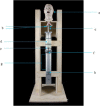Vomiting Larry: a simulated vomiting system for assessing environmental contamination from projectile vomiting related to norovirus infection
- PMID: 25419239
- PMCID: PMC4230971
- DOI: 10.1177/1757177414545390
Vomiting Larry: a simulated vomiting system for assessing environmental contamination from projectile vomiting related to norovirus infection
Abstract
Infectious diseases such as norovirus can induce emesis (vomiting), which can be of a projectile nature. Although studies have been carried out on transmission, prevalence and decontamination of such micro-organisms within various environments, little is known about the extent to which the surrounding environment is contaminated when an individual vomits. This is an important consideration for infection control purposes. The aim of this study was to develop a simulated vomiting system (Vomiting Larry) to be used for assessing the extent to which projected fluid can contaminate the environment. Vomiting Larry was set up within a Controlled Atmosphere Chamber (CAC) facility at the Health and Safety Laboratory (HSL). Simulated vomiting was undertaken using water as a vomitus substitute containing a fluorescent marker enabling small splashes, ordinarily missed, to be visualised using UV lighting. Experiments revealed that splashes and droplets produced during an episode of projectile vomiting can travel great distances (>3 m forward spread and 2.6 m lateral spread). The research highlighted that small droplets can be hard to see and therefore cleaning all contaminated surfaces is difficult to achieve. Evidence from this study suggests that areas of at least 7.8 m2 should be decontaminated following an episode of projectile vomiting.
Keywords: Emesis; Vomiting Larry; environmental contamination; infection control; norovirus; vomiting.
Conflict of interest statement
Declaration of conflicting interest: The author declares that there is no conflict of interest.
Figures




References
-
- Baker K, Morris J, McCarthy N, Saldana L, Lowther J, Collinson A, Young M. (2010) An outbreak of norovirus infection linked to oyster consumption at a UK restaurant, February 2010. Journal of Public Health 33(2): 205–11. - PubMed
-
- Brimacombe J, Keller C. (2006) Hypopharyngeal seal pressure during projectile vomiting with the ProSeal laryngeal mask airway: a case report and laboratory study. Canadian Journal of Anaesthesia 53(3): 328. - PubMed
-
- Caul EO. (1995) Hyperemesis hiemis – a sick hazard. Journal of Hospital Infection 30(Supplement): 498–502. - PubMed
-
- Guyton AC, Hall JE. (2011) Textbook of medical physiology, 12th edn Saunders Elsevier Inc: Amsterdam: 803–5.
Publication types
LinkOut - more resources
Full Text Sources
Other Literature Sources
